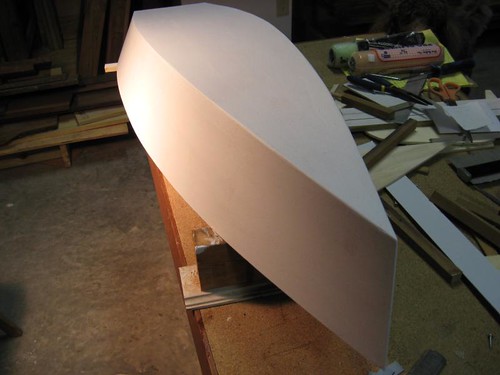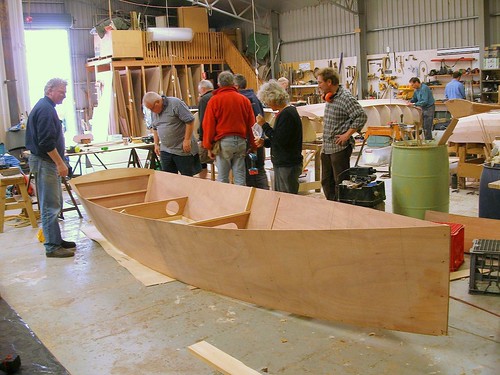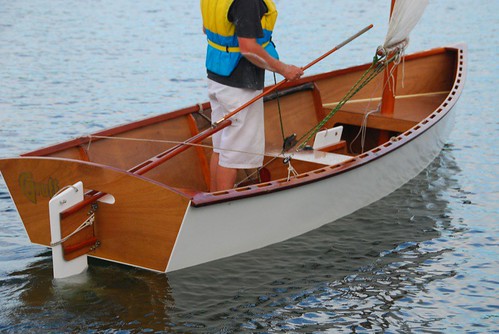
(this is a reprint of an article from the English Magazine Watercraft. They wanted an article on the Goat Island Skiff)
Maybe if you understand the boat, you understand the designer. Perhaps the reverse is true too.
I discovered sailing as a 12 year old when my family moved into a beachside house while our home was finished. The house was on Pittwater – an hour’s drive north of Sydney Harbour. It was the site almost chosen by Cook for the new colony and is a world class sailing area in its own right.
I was unaware of this as I out front of the house on a Sunday to find a mass of small boats and cats rigging. The rest is history – I haven’t stopped eating, drinking and breathing boats since.
Most of my early sailing years were involved in competitive sailing with some sailing dinghy cruising during school holidays. Then onto Uni and some uncompleted Naval Architecture studies (Bulk carriers loomed) and more racing in the Australian lightweight version of the 12sq metre Sharpie – very quick boats.

By the mid ’80s the racing scene had changed. New technology had been accepted by all the racing classes and the initial and running costs were discouraging both new and existing participants. This was even true of classes that had set out to be affordable to the average family.
A popular boat for two kids where I grew up is now $8000 and a class that was a sophisticated but aimed at reasonable price for two adults is now $16,000. The Sharpie above is up around $30,000.
So I dropped out of most racing. But I still delight in boats that are efficient to sail and efficient to handle.
On the “Round Australia Trip” that many young people take as an initiation I found myself employed by a tiny business in Adelaide – Duck Flat Wooden Boats – which was later to become the premier plan, kit and material supplier in the country.
It was an eye opener – customers were highly motivated to “do something with their own hands” and were building boats for a fraction of the cost of racing boats of similar size.
My ideas were quickly formed in this environment. Boats with good performance, that were easy to build, fun to sail and reasonably cheap to put together but retaining a strong traditional character. The main antipodean input was our tradition of boats that are dramatically lighter than Northern Hemisphere equivalents (average 10lbs/ft) but tough enough to deal with our stronger average winds and rougher waters.
While working at Duck Flat it was obvious that a few plans were very good at supporting people who had not built a boat before and others were not. Plans with poor detail and poor procedure consumed crazy amounts of time in the fledging business. The best plans, by far, were from Iain Oughtred who at that time had about 3 wonderfully documented designs. It was clear that the better the plans, the less work the designer and plans agent have to do in the long run! Lesson learned.
That leads to a slightly embarrassing confession … I am a really lazy boatbuilder. I might love the look of Nat Herreshoff’s Coquina , or an 1880’s sailing canoe with batwing sails … but I can’t even imagine building either! I want boats that build in weeks rather than months. We have other sailing canoe plans here.
So plywood is my first choice in materials – nothing speeds up boatbuilding (for the chronically lazy) or simplifies it more than this one choice. The second big influence in construction is a result of improvements in bonding technology. There are no permanent nails and screws which allows solid timber holding the bits of ply together can be quite small in dimension. Weight and the number of parts are both reduced but reliability and strength increased.

Less timber used in the boat saves money.
Less structure – saves weight – increases performance.
Fewer parts so the boat builds much more quickly.
FAQ to solve boatbuilding problems – lots of tips and tricks for using plywood, epoxy and more

But I was (and am still) in love with beautiful boats. Was it possible to create simple ply boats that just “look right” on the water? My first simplified hull shape in 1990, a sailing canoe, ended up quite pretty. About two designs later in ‘92 came the Goat Island Skiff (GIS).

So why is the GIS my favourite boat?
The main reason is the same as for many of the people who buy the plan – it looks wonderful. When my now friend Peter Hyndman built one of the first boats he used to have requests from his three teenage daughters to rig up the boat on the beach for them. When asked if they needed lifejackets they replied “No Dad – we are just going sit beside the boat and read – but the boat is a real bloke magnet”.
But importantly the good looks are supported by truly excellent sailing performance. Performance is close to conventional non-trapeze racing boats. Compared with colourful recreations of boats gone by – it sails rings around almost all of them and it sits well amongst the better sailing modern wood boats like Iain Oughtred’s.
My first sail of the GIS was a day of sailing on Brisbane’s Moreton Bay with 4 adults and a picnic aboard (700lbs/310kg) for a day of sailing in a nice sailing breeze. We covered a lot of ground upwind and down and could skim over shallows with the centreboard half up. I’ve also sailed the skiff by alone – last year to watch the Etchell World Championships or this year for a strong wind photoshoot. It’s a handful, but fun when gybing and tacking in stronger winds if the sail isn’t reefed.
I could go into detail about the reasons for the performance but I don’t have space here to elaborate. Much is taking some of the efficiencies of modern racing boats but incorporating them by design in a way that is invisible to the builder. Large and efficient-section foils (rudder and centreboard), slender bow, optimised volume distribution, light weight structure where possible and many refinements garnered from lots of sailing with simple balance lug rigs. All achieved with normal, moderate cost materials with labour minimised during the building process.
The hull is built “instant” style with no building jig required. For simple hullshapes I don’t think stitch and glue is warranted – real timber to hold the ply together is faster, more efficient and much smoother.
The hull is made up of four bulkheads and the transom prefabricated to fit between the two sides then turned over to fit the bottom. Add three seat tops, the centrecase, gunwales and inwales and it is time to start the spars and foils. Even I was surprised when this big, almost 16 footer came out at 127lbs for the complete hull before paint and varnish. Part of that is down to building of Gaboon/Okoume plywood which is highly recommended. It makes the boat so much easier to move around on land.
So a boat for lazy people who like pretty boats that go fast!